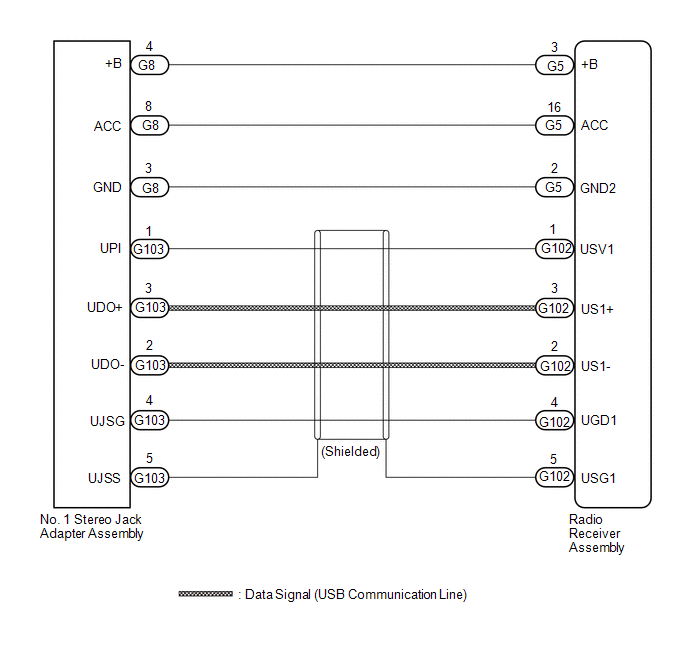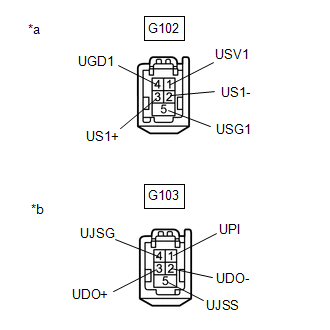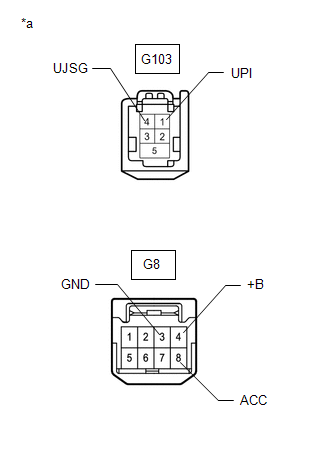Lexus ES: USB Audio System Recognition/Play Error
DESCRIPTION
When a USB device or "iPod" is connected to the USB jack of the No. 1 stereo jack adapter assembly, it must have playable files. The device must also communicate with and be recognized by the radio receiver assembly. This diagnostic procedure is for when a device is not recognized, or files from the device cannot be played normally.
WIRING DIAGRAM

CAUTION / NOTICE / HINT
NOTICE:
-
Depending on the parts that are replaced during vehicle inspection or maintenance, performing initialization, registration or calibration may be needed. Refer to Precaution for Navigation System.
Click here
.gif)
.gif)
-
When replacing the radio receiver assembly, always replace it with a new one. If a radio receiver assembly which was installed to another vehicle is used, the following may occur:
- A communication malfunction DTC may be stored.
- The radio receiver assembly may not operate normally.
HINT:
- When a large amount of data is in a USB device, it may take a while to begin playback.
- When using a USB device, files that are protected by copyright cannot be played.
-
When files are not played in the sorted order, perform the following procedure before inspection.
- Add numbers in front of the file names.
- Put the files in a folder and copy the folder data to the USB device.
PROCEDURE
| 1. | CHECK USB DEVICE OR "iPod" |
(a) Disconnect the USB device or "iPod" from the No. 1 stereo jack adapter assembly.
(b) Check if playable files are present on the USB device or "iPod".
HINT:
Refer to System Description for playable files.
Click here .gif)
.gif)
(c) Check if the USB device is a compatible format or "iPod" is a compatible version.
HINT:
Refer to System Description for compatible formats and versions.
Click here .gif)
.gif)
| Result | Proceed to |
|---|---|
| No playable files exist, or incompatible device format or version. | A |
| Playable files exist, and compatible device format or version. | B |
| A |  | END (USB DEVICE FORMAT IS INCOMPATIBLE, "iPod" VERSION IS INCOMPATIBLE, OR NO PLAYABLE FILES EXIST) |
|
| 2. | CHECK HARNESS AND CONNECTOR (RADIO RECEIVER ASSEMBLY - NO. 1 STEREO JACK ADAPTER ASSEMBLY) |
(a) Disconnect the G5 radio receiver assembly connector.
(b) Disconnect the G8 No. 1 stereo jack adapter assembly connector.
(c) Measure the resistance according to the value(s) in the table below.
Standard Resistance:
| Tester Connection | Condition | Specified Condition |
|---|---|---|
| G5-2 (GND2) - G8-3 (GND) | Always | Below 1 Ω |
| G5-3 (+B) - G8-4 (+B) | Always | Below 1 Ω |
| G5-16 (ACC) - G8-8 (ACC) | Always | Below 1 Ω |
| G5-2 (GND2) or G8-3 (GND) - Body ground | Always | 10 kΩ or higher |
| G5-3 (+B) or G8-4 (+B) - Body ground | Always | 10 kΩ or higher |
| G5-16 (ACC) or G8-8 (ACC) - Body ground | Always | 10 kΩ or higher |
| NG |  | REPAIR OR REPLACE HARNESS OR CONNECTOR |
|
| 3. | CHECK HARNESS AND CONNECTOR (RADIO RECEIVER ASSEMBLY - NO. 1 STEREO JACK ADAPTER ASSEMBLY) |
| (a) Disconnect the G102 radio receiver assembly connector. |
|
(b) Disconnect the G103 No. 1 stereo jack adapter assembly connector.
(c) Measure the resistance according to the value(s) in the table below.
Standard Resistance:
| Tester Connection | Condition | Specified Condition |
|---|---|---|
| G102-1 (USV1) - G103-1 (UPI) | Always | Below 1 Ω |
| G102-2 (US1-) - G103-2 (UDO-) | Always | Below 1 Ω |
| G102-3 (US1+) - G103-3 (UDO+) | Always | Below 1 Ω |
| G102-4 (UGD1) - G103-4 (UJSG) | Always | Below 1 Ω |
| G102-5 (USG1) - G103-5 (UJSS) | Always | Below 1 Ω |
| G102-1 (USV1) or G103-1 (UPI) - Body ground | Always | 10 kΩ or higher |
| G102-2 (US1-) or G103-2 (UDO-) - Body ground | Always | 10 kΩ or higher |
| G102-3 (US1+) or G103-3 (UDO+) - Body ground | Always | 10 kΩ or higher |
| G102-4 (UGD1) or G103-4 (UJSG) - Body ground | Always | 10 kΩ or higher |
| G102-5 (USG1) or G103-5 (UJSS) - Body ground | Always | 10 kΩ or higher |
| NG |  | REPAIR OR REPLACE HARNESS OR CONNECTOR |
|
| 4. | CHECK RADIO RECEIVER ASSEMBLY (NO. 1 STEREO JACK ADAPTER ASSEMBLY POWER SOURCE) |
| (a) Disconnect the G103 and G8 No. 1 stereo jack adapter assembly connectors. |
|
(b) Measure the voltage according to the value(s) in the table below.
Standard Voltage:
| Tester Connection | Condition | Specified Condition |
|---|---|---|
| G103-1 (UPI) - G103-4 (UJSG) | Engine switch on (ACC) | 4.5 to 5.5 V |
| G8-8 (ACC) - G8-3 (GND) | Engine switch on (ACC) | 11 to 14 V |
| G8-4 (+B) - G8-3 (GND) | Always | 11 to 14 V |
| NG |  | REPLACE RADIO RECEIVER ASSEMBLY |
|
| 5. | FORMAT USB DEVICE OR RESTORE "iPod" AND RECHECK |
(a) Delete all files in the USB device or "iPod" and format/restore it.
(b) Save the data again and check if it can be played on the in-vehicle device.
NOTICE:
Formatting a USB device or restoring an "iPod" erases all music on the device. Ensure that backup music data is available before performing this operation.
HINT:
Make sure to obtain the customer's permission to perform this procedure.
OK:
Malfunction disappears.
| OK |  | END |
|
| 6. | REPLACE USB DEVICE OR "iPod" |
(a) Turn the engine switch off.
HINT:
When this malfunction occurs, it is necessary to turn the engine switch off to make it possible for the vehicle to recognize a new device when it is connected.
(b) Turn the engine switch on (ACC).
(c) Connect a known good USB device or "iPod" to the No. 1 stereo jack adapter assembly.
HINT:
- If the malfunction occurred when a USB device was in use, use another USB device for the inspection. If the malfunction occurred when an "iPod" was in use, use another "iPod" for the inspection.
-
Refer to System Description for compatible formats and versions.
Click here
.gif)
.gif)
|
| 7. | CHECK USB DEVICE OR "iPod" |
(a) Check if a USB device or "iPod" is recognized by the radio receiver assembly, and if information such as track, artist and album names is displayed on the screen.
OK:
USB device or "iPod" is recognized properly and the information is displayed on the screen.
| OK |  | USB DEVICE OR "iPod" WAS INCOMPATIBLE OR DEFECTIVE |
| NG |  | PROCEED TO NEXT SUSPECTED AREA SHOWN IN PROBLEM SYMPTOMS TABLE |




